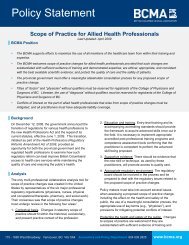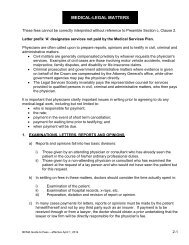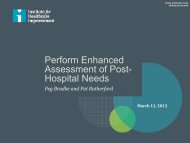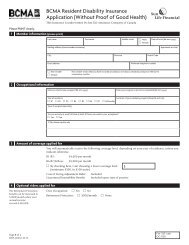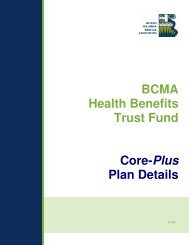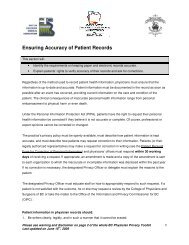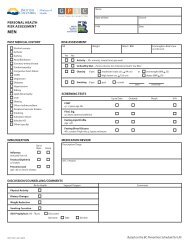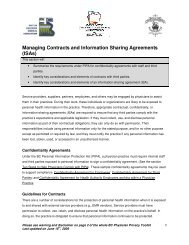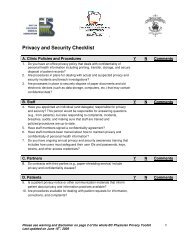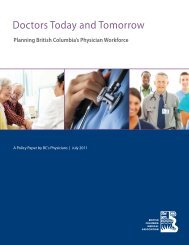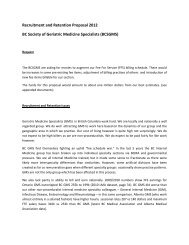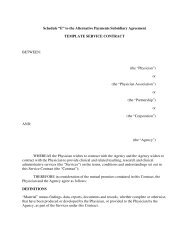Enhancing Surgical Care in BC - British Columbia Medical Association
Enhancing Surgical Care in BC - British Columbia Medical Association
Enhancing Surgical Care in BC - British Columbia Medical Association
You also want an ePaper? Increase the reach of your titles
YUMPU automatically turns print PDFs into web optimized ePapers that Google loves.
etter understand not only their part of the process but how each component is related and <strong>in</strong>terdependent. Overall, it is<br />
crucial for cl<strong>in</strong>ical leaders and adm<strong>in</strong>istrators to work as a team <strong>in</strong> a constructive and collaborative environment. A good<br />
work<strong>in</strong>g relationship between the key players can help to improve and enhance the effectiveness of the OR system and<br />
ensure that improvements are susta<strong>in</strong>ed (Calmes & Shusterich, 1992).<br />
Although recommendations <strong>in</strong> this policy paper are directed toward improv<strong>in</strong>g surgical care, it must be recognized that the<br />
development of such an organizational culture will have benefits for the organization that extend far beyond the surgical<br />
suites; such a culture may well enhance effectiveness and efficiency <strong>in</strong> other parts of the hospital system as well.<br />
III. Leadership<br />
Strong leadership, both at the senior management and program levels, is critical to success (Nolan, 2007). Senior leadership<br />
at the health authority and hospital, <strong>in</strong>clud<strong>in</strong>g the board, CEO, and senior executives, should be actively engaged to drive<br />
and support change. The likelihood of successfully implement<strong>in</strong>g and susta<strong>in</strong><strong>in</strong>g improvement <strong>in</strong> perioperative efficiencies<br />
is enhanced when senior executives:<br />
• Champion the adoption of cultural change <strong>in</strong>to the organization, which <strong>in</strong>cludes open communication and<br />
teamwork, the cont<strong>in</strong>uous pursuit of improvement, and the empowerment of cl<strong>in</strong>ical providers to generate and<br />
implement <strong>in</strong>novative solutions based on best practice.<br />
• Provide clear direction about the strategic objectives for the hospital and ensure that the perioperative program is<br />
aligned with those objectives through accountability mechanisms.<br />
• Demonstrate visible leadership and engage with staff, provid<strong>in</strong>g legitimacy to the <strong>in</strong>itiative and mak<strong>in</strong>g staff aware of<br />
the commitment and support of senior leadership.<br />
• Provide the appropriate resources for staff tra<strong>in</strong><strong>in</strong>g and change management, such as free<strong>in</strong>g up staff time and<br />
assign<strong>in</strong>g dedicated resources to participate <strong>in</strong> the <strong>in</strong>itiatives.<br />
Leadership is also crucial at the perioperative program level. To effectively plan and manage the program, a leadership team<br />
is needed and should <strong>in</strong>clude representatives from adm<strong>in</strong>istration, surgery, anesthesiology, nurs<strong>in</strong>g, and other cl<strong>in</strong>ical and<br />
ancillary providers. The role of the perioperative leadership team with<strong>in</strong> each hospital is essential to:<br />
• Develop a practical and realistic plan for <strong>in</strong>itiat<strong>in</strong>g and susta<strong>in</strong><strong>in</strong>g perioperative improvement.<br />
• Def<strong>in</strong>e perioperative management goals and set measurement <strong>in</strong>dicators with a process to monitor and evaluate<br />
performance at the level of the <strong>in</strong>dividual provider, service, and system.<br />
• Conduct a hospital self-assessment of the perioperative process and to determ<strong>in</strong>e where blockages or bottlenecks<br />
occur, focus<strong>in</strong>g on improv<strong>in</strong>g those areas that add value to the process.<br />
• Ensure optimal coord<strong>in</strong>ation and communication across the entire perioperative process.<br />
• Use measurement <strong>in</strong>dicators to help drive evidence-based decision mak<strong>in</strong>g to improve the quality and patient safety<br />
outcomes, as well as the efficiency of the program.<br />
IV. Patient Focus and Patient Engagement<br />
Develop<strong>in</strong>g a perioperative improvement program with a strong patient focus is <strong>in</strong>tegral to improv<strong>in</strong>g the quality and<br />
safety of surgical care, as well as the efficiency of service delivery. The patient perspective must be <strong>in</strong>corporated <strong>in</strong>to any<br />
31 <strong>Enhanc<strong>in</strong>g</strong> <strong>Surgical</strong> <strong>Care</strong> <strong>in</strong> <strong>BC</strong> – Part 4: Best Practices, Lessons Learned, and Critical Success Factors



